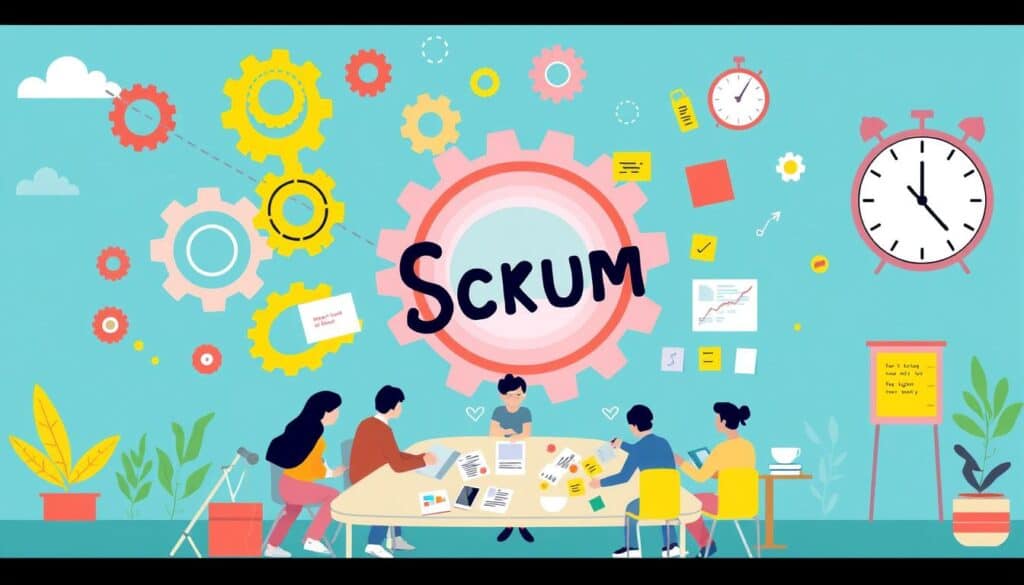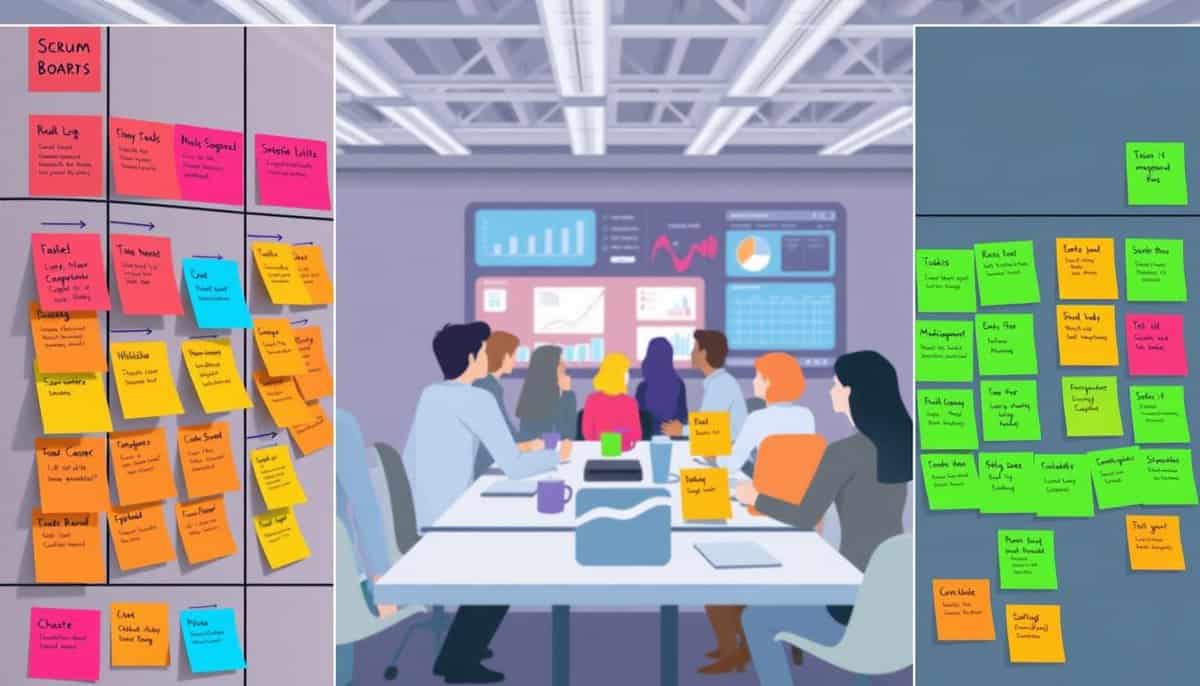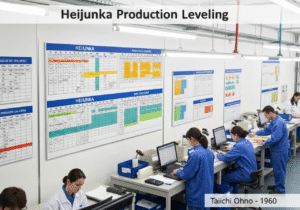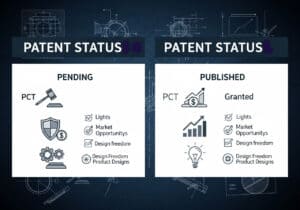Did you know that over 70% of modern agile projects use Scrum? It’s a dynamic approach aimed at quickly delivering top-quality products. Scrum includes five key stages: beginning, planning, doing the work, reviewing, and releasing. Each stage is set up for great teamwork, flexibility, and ongoing betterment of complex projects.
The Scrum method has changed how teams collaborate. By dividing big tasks into shorter sprints—usually 2 to 4 weeks—teams can focus on creating parts of the product that are ready to go. Also, with daily quick meetings and burndown charts, teams keep a clear and efficient check on their progress.
Key Takeaways
- The Scrum methodology encompasses five essential phases: initiation, planning and estimation, implementation, review and retrospective, and release.
- Scrum teams work in 2-4 week sprints to deliver incremental improvements.
- Daily stand-up meetings help maintain clarity and focus among team members.
- Burndown charts track progress against the project timeline.
- Scrum promotes a culture of continuous improvement and user feedback.
Introduction to the Scrum Methodology
Scrum methodology is a key part of agile development, changing how teams handle complex projects. It focuses on step-by-step progress, adaptability, and team work. This Scrum introduction explains its basics and how it fits into agile project management.
What is Scrum?
Scrum is a framework for managing complex projects, mainly in software development. It encourages open communication within teams, preventing misunderstandings and information blocks. Scrum is built on five core values: commitment, courage, focus, openness, and respect. This creates a culture of ongoing improvement and teamwork.
The core of Scrum includes three main artifacts: Product Backlog, Sprint Backlog, and Increment. These are vital for planning and carrying out projects well. The Product Backlog lists all tasks, the Sprint Backlog selects tasks for the next sprint, and the Increment is the completed work.
Scrum teams, often comprising about 10 people, include three roles: Product Owner, Scrum Master, and development team. This team is small enough to feed with two pizzas. It includes designers, testers, and developers.
The Importance of Agile Project Management
Agile project management is key for constant improvement and delivering top-quality products. It differs from traditional methods by emphasizing flexibility and team suggestions to meet changing client needs. Scrum meets these needs through various events like Sprint Planning and Daily Scrum.
With frequent reviews, teams can check their progress and adjust as needed. This helps keep projects on budget and on time. Agile’s flexibility means Scrum teams can change task priorities based on new customer requirements. This leads to more regular product releases and better project results.
“Scrum methodology enables teams to function more efficiently and maintain high standards of quality. Small steps and iterative practical approach are the keys to happier and more productive teams.”
Scrum’s success comes from how it organizes and directs teams on complex projects while staying adaptable. As part of agile project management, Scrum helps deliver higher-quality results through a defined, cooperative process.
The Benefits of the Scrum Methodology
The benefits of Scrum are many, especially for modern project management. It emphasizes teamwork within the scrum team and focuses on making small, steady progress. This way, organizations can work more efficiently and be ready for changes. Teams use short sprints, from one to four weeks long, to stay flexible and quickly adjust to new feedback or changes. This section talks about how Scrum helps with flexibility, teamwork, and making better products.
Increased Flexibility and Adaptability
Scrum’s main benefit is making teams more flexible and ready for change. Teams have short, two to four-week sprints to quickly tackle changes and use new feedback. This method keeps the scrum team on track with the project’s evolving goals and needs, making sure the end product meets what the customer wants. Plus, with regular sprint reviews and look-backs, teams can constantly improve, making it easier to adjust and fix course as needed.

Enhanced Team Collaboration
Scrum really focuses on better teamwork. Daily stand-up meetings, capped at 15 minutes, help keep everyone on the same page and spotlight any issues. This way, problems are seen and solved quickly. The team’s varied skills lead to better problem-solving, all thanks to Scrum’s focus on working together closely. Good communication is key in Scrum, creating a supportive and efficient team environment.
Improved Product Quality
The Scrum framework’s iterative, step-by-step approach leads to improved product quality. Through regular checks like sprint reviews and retrospectives, the team can see progress and find what needs to be better. By focusing on finishing product segments, putting function before process, the result is happier customers. Also, because teams manage themselves, there’s a stronger feeling of ownership and a bigger drive to innovate, pushing quality and creativity to the forefront.
Understanding Roles and Responsibilities
In Scrum, defined roles and responsibilities are key for success. The roles—product owner, scrum master, and development team—work together. They ensure smooth work and continuous improvement.
The Role of the Product Owner
The product owner is crucial in managing the product backlog. This list includes features, bug fixes, and enhancements. They handle release management and talk to stakeholders. Their goal is to make sure the product meets business goals.
The Role of the Scrum Master
The scrum master helps the team use Scrum well. They focus on being open, using real data, and letting the team organize itself. They ensure the team follows Scrum values. They also run daily scrum meetings to keep everyone informed and in sync.
The Role of the Development Team
The development team includes engineers, designers, writers, and programmers. They work together to make great product pieces. The Scrum methodology suggests having 10 or fewer people for the best communication and results. The team decides how they work, aiming to get better with every sprint.
- Transparency: daily meetings make the team’s work clear to all.
- Self-organization: team members can decide on their work.
- Collaboration: working closely ensures quality product pieces are made.
Knowing the scrum roles is vital for using Scrum well. Each role has its duties. Together, they make the workflow smooth and deliver value to the customers.
Planning a Timeline and Setting Objectives
Effective Scrum planning is vital for teams aiming to deliver top-quality products on time. It begins with a detailed and ranked product backlog, managed by the Product Owner. To succeed in release planning, Scrum teams work closely. This makes sure every task is clear and manageable.
The Importance of Product Backlog
A good product backlog is key to successful sprint planning. It’s an organized list of everything needed in the product. The 14th State of Agile report shows structured backlog refinement helps agile success. About 58% of Agile users say...
You have read 36% of the article. The rest is for our community. Already a member? Log in
(and also to protect our original content from scraping bots)
Innovation.world community
Login or Register (100% free)
View the rest of this article and all members-only content and tools.
Only real engineers, manufacturers, designers, marketers professionals.
No bot, no hater, no spammer.
FAQ
What is the Scrum methodology?
Scrum is a framework for managing projects, often used in software development. It supports team collaboration on complex tasks. The process is flexible and adapts well to changes.
What is the importance of agile project management?
Agile project management, like Scrum, focuses on continuous growth and flexibility. It values team input and aims to deliver high-quality products. This approach helps teams quickly adapt to changes and meet their goals.
What are the key benefits of the Scrum methodology?
Scrum offers many advantages. It improves flexibility and team collaboration. Teams meet daily and review their work regularly, leading to better products.
What are the roles of a Product Owner in Scrum?
The Product Owner guides the project’s vision. They rank tasks by importance and keep the product backlog organized. This ensures the project stays on track.
What does a Scrum Master do?
A Scrum Master supports the team by promoting Scrum and Agile practices. They help solve problems that might slow down the team’s work.
What is the role of the Development Team?
The Development Team focuses on completing tasks within sprints. They work closely to ensure each product increment is of high quality.
What is a product backlog and why is it important?
A product backlog is a list of tasks for the team to do. It’s prioritized by the Product Owner. This list helps plan sprints and keep the project on target.
What is involved in effective sprint planning?
In sprint planning, teams pick tasks from the backlog to work on. They plan their next few weeks and set specific goals for the sprint.
What are daily standup meetings?
Daily standups are short meetings where the team shares updates. They discuss any challenges and plan their day. This keeps everyone aligned and focused.
How does a burndown chart help in Scrum?
A burndown chart shows the work left over time. It keeps the team aware of their progress towards sprint goals. This transparency helps the team stay on schedule.
What is the Scrum framework in practice?
Using Scrum means training the team, setting up roles, and starting with a pilot project. Sometimes, adjustments are necessary to fit the organization’s needs.
What are sprint reviews and why are they important?
Sprint reviews involve sharing progress with stakeholders. They’re key for feedback and making updates before the next sprint starts.
Why are sprint retrospectives essential?
Sprint retrospectives let the team evaluate their sprint. They find ways to improve and plan for future sprints. This is crucial for ongoing improvement.
What is product backlog grooming?
Backlog grooming means updating and reprioritizing the backlog. It keeps the list relevant to project goals and responsive to changes.
What does the release phase in Scrum involve?
The release phase is about final prep for delivery. It includes testing and integration to ensure the product meets quality standards before launch.
How can teams handle scope creep in Scrum?
Teams manage scope creep by keeping a clear backlog, setting definite objectives, and talking regularly with stakeholders. Regular grooming helps adapt to changes.
How can teams manage tight deadlines in Scrum?
Managing tight deadlines involves prioritizing tasks, setting achievable goals in sprint planning, and using tools like burndown charts. Daily meetings help monitor progress.
Glossary of Terms Used
User Interface (UI): a system that enables interaction between users and software applications, encompassing visual elements, controls, and overall layout to facilitate user tasks and enhance experience.



























I completely agree that defined roles and responsibilities, along with effective sprint planning and backlog management, are essential for keeping teams agile and responsive.
would be interesting to see more discussion on how to handle common challenges like scope creep and team burnout.
it might be helpful to include examples of tools or techniques, other than Asynchronous Planning Poker
Great read! But isnt it possible that Scrums rigid structure could stifle creativity in some teams? Just food for thought.
Just curious, wouldnt the Scrum process be more effective if we incorporate lean principles?
Is Scrum really the answer to all project management woes or just another buzzword? Is it truly applicable to all industries?
Does anyone feel Scrum is overrated? I mean, there are other Agile methods just as effective, if not more!
Scrums not overrated, its just misused. Other Agile methods have their own share of flaws too!